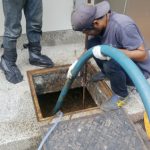The Science Behind Grease Trap Pumping
March 15, 2024 5:51 pm Leave your thoughts
What is a Grease Trap?
Before diving into the science behind grease trap pumping, it’s important to understand what a grease trap is and how it functions. A grease trap is a plumbing device that is designed to intercept grease, oil, and fats from wastewater before it enters the municipal sewer system. Grease traps are typically located in the kitchen or food preparation area of a commercial establishment, where they collect these substances and prevent them from solidifying and causing blockages down the line.
How Does a Grease Trap Work?
Grease traps work based on a simple principle of physics – buoyancy. When wastewater containing grease, oil, and fats enters the grease trap, these substances separate from the water due to their lower density. The lighter grease, oil, and fats rise to the surface of the trap, while the heavier water continues to flow through the system. Over time, the grease, oil, and fats accumulate at the top of the trap, forming a layer of scum.
Why is Grease Trap Pumping Necessary?
While grease traps are effective at intercepting grease, oil, and fats, they can only hold a limited amount of these substances before they need to be pumped out. Regular grease trap pumping is necessary to remove the accumulated grease, oil, and fats from the trap before they start to cause problems. If grease trap pumping is neglected, the layer of scum can solidify and block the flow of water through the trap, leading to backups, foul odors, and potential environmental damage.
The Science Behind Grease Trap Pumping
When it comes to grease trap pumping, science plays a crucial role in understanding how the process works and why it is necessary. As grease, oil, and fats accumulate in the grease trap, they undergo a process called microbial degradation. Microorganisms present in the trap break down the organic matter in the grease, oil, and fats, converting them into simpler compounds like carbon dioxide and water.
However, microbial degradation is a slow process, and over time, the accumulated grease, oil, and fats can exceed the capacity of the microorganisms in the trap to break them down. This is where grease trap pumping comes in – by removing the excess grease, oil, and fats from the trap, grease trap pumping helps to maintain the balance of organic matter in the trap and prevent clogs and backups.
The Science of Grease Trap Pumping Techniques
There are several techniques used for grease trap pumping, each with its own scientific basis. One common technique is to use a vacuum truck to suction out the accumulated grease, oil, and fats from the grease trap. This method relies on the principle of negative pressure to create suction, pulling the grease, oil, and fats out of the trap and into the vacuum truck for disposal.
Another technique used for grease trap pumping is to use a pump to agitate the contents of the trap and break up the layer of scum. This method helps to loosen the grease, oil, and fats and facilitate their removal from the trap. By mixing the contents of the trap, this technique also helps to expose more of the organic matter to the microorganisms in the trap, enhancing the process of microbial degradation.
The Importance of Regular Grease Trap Pumping
The science behind grease trap pumping is essential for understanding why this maintenance task is necessary for commercial kitchens and restaurants. Grease traps work based on the principle of buoyancy, intercepting grease, oil, and fats from wastewater before they enter the sewer system. Grease trap pumping is necessary to remove the accumulated grease, oil, and fats from the trap before they cause blockages and backups. By understanding the science behind grease trap pumping and techniques used for this task, commercial establishments can ensure the proper maintenance of their grease traps and prevent costly plumbing issues. Regular grease trap pumping is a small investment that can yield significant returns in terms of preventing clogs, backups, and environmental damage.
Need a Septic Tank & Grease Trap Cleaning Company in Farmington, NH?
B.H. Cameron Septic Services LLC has been proudly serving the surrounding counties since 2005, providing efficient, cost-effective solutions to meet your residential or commercial septic system needs. We will help you develop your initial design and secure permits for installation or provide conversion to the city sewer system. We offer peace of mind with routine maintenance service after the job is done. When you contact B.H. Cameron Septic Services LLC, you will be greeted by one of our customer service staff. An experienced service technician will work directly with you to determine how we can help with your septic service or maintenance. Call us today!
Categorised in: Grease Trap Cleaning, Grease Trap Pumping
This post was written by admin
